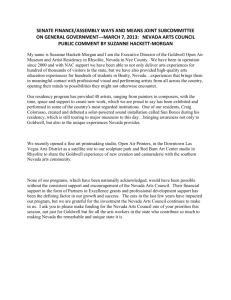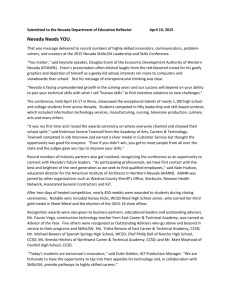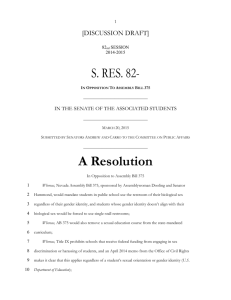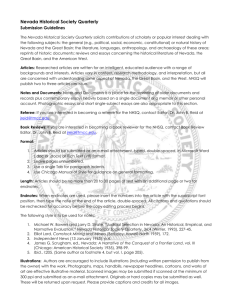Agenda Item IV - Adapt Courseware Presentation
advertisement
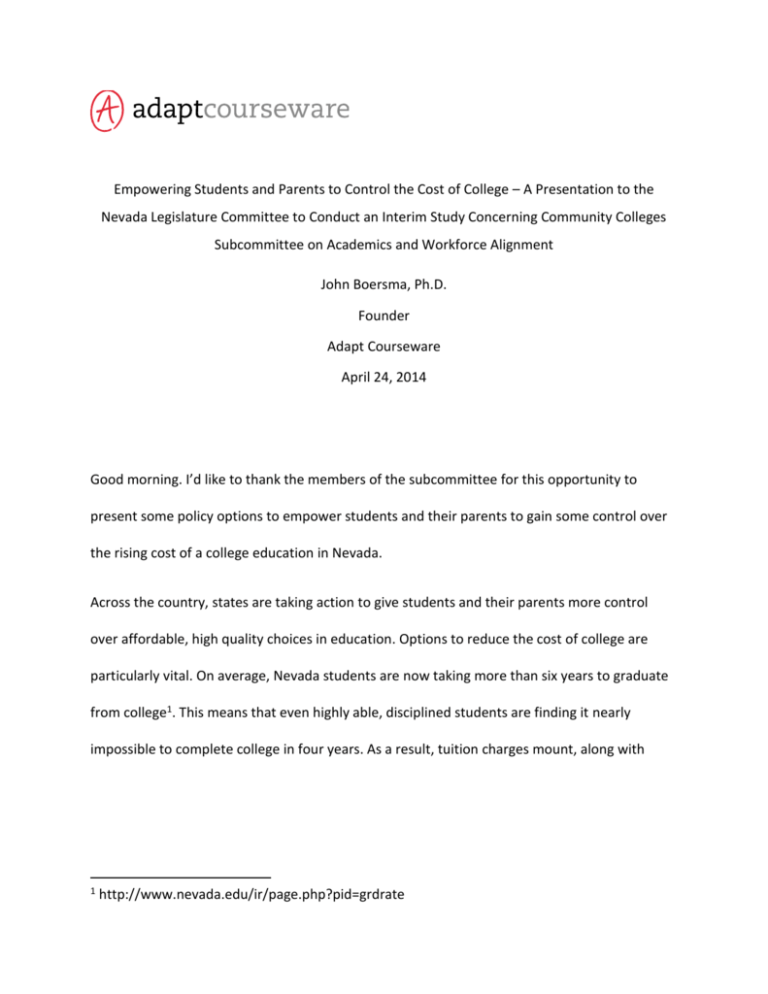
Empowering Students and Parents to Control the Cost of College – A Presentation to the Nevada Legislature Committee to Conduct an Interim Study Concerning Community Colleges Subcommittee on Academics and Workforce Alignment John Boersma, Ph.D. Founder Adapt Courseware April 24, 2014 Good morning. I’d like to thank the members of the subcommittee for this opportunity to present some policy options to empower students and their parents to gain some control over the rising cost of a college education in Nevada. Across the country, states are taking action to give students and their parents more control over affordable, high quality choices in education. Options to reduce the cost of college are particularly vital. On average, Nevada students are now taking more than six years to graduate from college1. This means that even highly able, disciplined students are finding it nearly impossible to complete college in four years. As a result, tuition charges mount, along with 1 http://www.nevada.edu/ir/page.php?pid=grdrate student debt, and productive careers are deferred. The average student in Nevada is now leaving college with over $20,000 in student loan debt2. Let’s look at the four-year graduation rate closely. The national average across all public and private four-year institutions is 41%3. Of course, institutions vary widely in student population, funding, and other characteristics. It is perhaps more interesting to look at this statistic for a set of similar institutions. Here are the results for a variety of four-year public institutions in the West. 2 http://projectonstudentdebt.org/state_by_state-data.php http://www.usnews.com/education/best-colleges/the-short-listcollege/articles/2013/10/15/10-schools-with-the-highest-4-year-graduation-rates 3 Four-year graduation rates are now down to 17% at the University of Nevada at Reno, and 15% at the University of Nevada at Las Vegas4. Why so low, and so comparatively low? As in California, a key, controllable factor is a lack of capacity in Freshman- and Sophomore-level general education courses, like Introduction to Psychology and Financial Accounting. Students face closed sections and wait-lists in the courses they need to progress to advanced courses, delaying their entire degree program. A key reason for this lack of capacity is outdated instructional models that haven’t kept up with the times. Better ways to engage students to succeed (so they don’t need to repeat the course, adding to the capacity problems) and better ways to use valuable instructor time are underutilized. A modern, effective curriculum should be student-centered and paced, competency-based, and use instructor time to relate one-on-one with individual students and small groups as needed. 4 http://colleges.usnews.rankingsandreviews.com/best-colleges/university-of-nevada-lasvegas-2569 One example of such curriculum is that provided by Adapt Courseware, who I am representing today. By combining modern multimedia instructional techniques with personalized online instruction, an approach we call adaptive multimedia, we produce 15% or better student success rates in a highly scalable model, where an instructor can support many more students while providing each a higher level of personal attention than with traditional methods. DIFFERENT PATHS TO COMPETENCY Maria Walter ACTIVITIES PRESENTED With a modern, adaptive multimedia system, each student receives the instruction and assignments they need to master each topic. In this example, Maria reached competency with eight learning activities, while Walter required 17. But each reached the same, good level of understanding. This is instead of the traditional method of fixed assignments where either Walter would have been left at understanding only half the concepts, or Maria would have been bored with needless additional work. We are in close consultation with the Nevada System of Higher Education e-Learning Task Force to bring these methods to Nevada higher education, but that is not enough. These instructional experiences, for core general education topics, should be available directly to students and their parents, so that they can get a head start on the too long road to a college degree. Fortunately, there are straightforward policy proposals available that can make this possible: Nevada should implement a mini-voucher program, where High School students and their parent can allocate course-level funding to alternative providers, especially where local schools do not offer specific courses. High school students should be able to direct, at the course level, public funds allocated to them to providers of alternative courses approved by the Nevada Superintendent of Public Instruction. This is particularly important where local schools do not offer Advanced Placement (AP) courses, as is the case with about a third of all High Schools. Mini-vouchers have been implemented in Louisiana5, Florida, and Texas6. Let’s say a high school student would 5 6 http://www.louisianacoursechoice.net/ http://www.txvsn.org/portal/ like to get a jump-start on college by taking a college level course in Introduction to Psychology, but this is not offered at the local High School. The student would be able to take such a course from an approved provider, with a portion of the state funds allocated to them. All Nevada public colleges and universities should accept and support introductory college level credit by exam. In addition to all AP7 exams, all College Level Examination Program (CLEP)8 results should be accepted for degree and major program credit. These exam programs provide high-quality, low cost means to gain substantial credit towards the first two years of college, reducing cost and reducing strain on overloaded introductory courses. Most US colleges accept AP and CLEP toward degree programs – all should. Similarly, all colleges should accept the recommendations of the American Council of Education (ACE)9 on credit transfer from non-accredited providers. All Nevada public colleges and universities should recognize for credit equivalent offerings of all other Nevada public institutions. A freshman Psychology or Accounting course, for example, at one Nevada public college should be accepted for degree and program credit at all colleges. Credit in the top 50 highest enrollment courses should be guaranteed among NSHE institutions. Universal credit transfer has been adopted in Louisiana and Florida. 7 https://apstudent.collegeboard.org/home http://clep.collegeboard.org/ 9 http://www.acenet.edu/news-room/Pages/College-Credit-Recommendation-ServiceCREDIT.aspx 8 Enactment of these proposals will make a big difference in Nevada education, by giving students and parents access to more high-quality choices, reducing time to degree completion, and reducing student loan debt. These proposals will provide incentives to students to seek out low-cost, high quality alternatives like community colleges, and provide incentives to all public institutions to vigorously explore ways to increase the efficiency of instruction while maintaining quality. Nevada has an opportunity to lead nationally with comprehensive legislation on freedom of choice in public higher education. Thank you for your interest, and I’d be pleased to answer any questions you may have.


